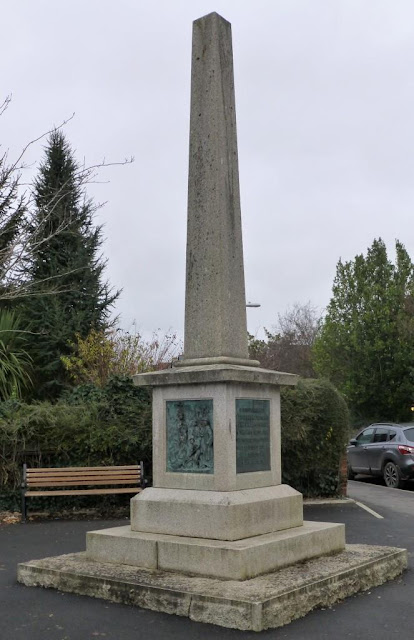East Budleigh’s link to an Exeter Memorial
The Protestant Martyrs’ Memorial in Exeter, at the corner of Barnfield Road and Denmark Road
August
1557. The Catholic Queen Mary has been on the throne of England since 1 October
1553. She is determined to reverse the changes in religion that have occurred
since the Protestant Reformation took place during the reign of her father King
Henry VIII. Over the last two years, since February 1555, a total of 227
‘heretics’ – men and women, two of them pregnant – have been put to death. All,
except for one, were burnt alive.
The 228th is a Cornishwoman by the name of Agnes Prest. Denounced by her husband, she’s been arrested as a ‘heretic’, transported to Exeter and condemned to death by burning ‘for refusing to worship a piece of bread as God’.
No doubt she has also caused a scandal by speaking out about such matters of theology, for which women are considered ill-suited. A good wife, say the authorities, should rather concern herself with household matters.
Hayes Barton
Perhaps, they wondered, there might be a good wife living locally who might succeed in persuading Agnes Prest to renounce her views and repent of her scandalous behaviour.
And thus it was that a dozen
or so miles away in East Budleigh, at the farmhouse of Hayes Barton on Hayes
Lane, Katherine Raleigh may have come to hear of the arrest of this Protestant
‘heretic’.
Arms of the Champernowne
family: ‘Gules, a saltire vair
between twelve billets or’. Image credit: Lobsterthermidor
Katherine herself was no mere farmer’s wife. Her husband, Walter Raleigh of Fardel Manor, Ivybridge, was a Member of Parliament for Devon. Born a Champernowne she herself was a member of one of Devon’s oldest families of landed gentry. She was, it seems, known as ‘a woman of noble wit and godly ways’.
A replica Tudor rosary, similar to one on display in the Ralegh Room at
Budleigh Salterton’s Fairlynch Museum
Walter
Raleigh may have suggested to his wife that she visit the poor woman in prison
to try and make her see sense. Katherine was intrigued. Both she and her
husband had accepted some of the rules drawn up by previous governments during
the reign of the Protestant King Edward VI. Rules such as the banning of
rosaries, considered superstitious nonsense by Protestant theologians. Now, of
course, such ‘superstitions’ had made a come-back under the Catholic Queen
Mary.
What kind of person was this Agnes Prest, she wondered? Some people thought that she was simply a crazed woman rather than a serious ‘heretic’. The Bishop of Exeter himself had concluded that she was a ‘mased creature and not in her perfect wit’.
The
poor woman had a husband and family who had disowned her because of their
religious differences. Was this so-called ‘heretic’ ready to abandon her
children? Was she really so determined to face a dreadful death by fire for
refusing to give up her beliefs? Katherine was curious to know the answers.
Remains of Rougemont Castle, Exeter. Image credit: Wikipedia
Thanks to her family connections, even if she had not been asked to try and make the prisoner see sense, she would have had little difficulty in gaining access to Exeter’s Rougemont Castle where the prisoner was being held until her execution. And there in her prison cell did Agnes Prest, an uneducated woman of the lower orders, astonish Katherine, displaying a depth of knowledge in religious matters and a simple eloquence that struck her visitor as divinely inspired.
A page from the first edition of Actes and
Monuments, also known as Foxe's Book of Martyrs, published in 1563. Image
credit: Wikipedia
As
the 16th century historian John Foxe would later write, Katherine
‘bore ample testimony of her godly conversation, declaring, that unless God
were with her, it were impossible she could have so ably defended the cause of
Christ’.
There is every reason to think that her son, the future
Sir Walter Raleigh, would have been inspired in his enmity towards Catholicism
by his mother’s account of the event. As a teenager he gained his first
military experience in France, fighting with a force made up of Devon’s
Protestant families to support the Huguenots during the French Wars of
Religion.
The bronze panel seen above shows the execution of Agnes Prest, burnt to death on 15 August 1557 at Southernhay, Exeter. It is one of four panels on the Protestant Martyrs' Memorial in St Leonard’s, Exeter, which was erected as the result of a public subscription. Another panel shows Thomas Benet, executed at Livery Dole in 1531, during the reign of Henry VIII. The Memorial was unveiled by the MP for Honiton, Sir John Kennaway, on 20 October 1909, following a service in the now demolished Bedford Chapel in Bedford Circus, Exeter.
Harry Hems
at work in his studio in Longbrook Street in Exeter, Devon, England, on 12 June
1896. Image from Stone Magazine, June 1899; Wikipedia
Harry
Hems was an English architectural and ecclesiastical
sculptor who was particularly inspired by the Gothic architecture prevalent in
Europe from the 12th to the 16th centuries. He was a
practitioner of the Gothic Revival movement which started in the mid-18th
century.
The
former workshop of Harry Hems in Longbrook Street, Exeter, Devon, England. It
now houses a restaurant on the ground floor. Image
credit: Smalljim
He founded and ran a large workshop in Exeter, Devon, which produced woodwork and sculpture for churches all over the country and abroad. A large part of the collection of medieval woodwork that he accumulated during his working life is now in the Royal Albert Memorial Museum in Exeter.
More work by Harry Hems: the Wallingford screen at St Alban's Cathedral, restored by Hems. Image credit: MykReeve
Located on the corner
of Barnfield Road and Denmark Road, in a residential part of Exeter away from
the city centre, I don’t suppose that the Protestant Martyrs Memorial attracts
many visitors. Which is a shame in many ways, because it is a fine example of
Harry Hems’ work. Yet perhaps the quiet location of the monument next to a
bench encourages the visitor to contemplate more fully those terrible times of
religious intolerance and the cruelty of the persecutors.
Higher Cemetery, St Mark’s Avenue, Exeter Image credit Julia&Keld www. findagrave.com
A particular supporter of the campaign to build a monument was Emma Miller, Honorary Secretary of the Exeter Protestant Martyrs’ Memorial Committee, who is described as instrumental in its creation. She was presented with an illuminated address and a duplicating machine by the memorial committee in recognition of her work towards providing the memorial.
Born in 1861, unmarried
and living at 11 St John’s Road in Exeter, she died in 1928 and is buried in the
city’s Higher Cemetery. It is perhaps significant that her grave is in the
Dissenters’ part of the cemetery.
Some people might well be puzzled by the memorial’s location in St Leonard’s. An inscription on the monument tells us that it was ‘near this spot’ that the martyrs met their deaths. In fact we are some distance from the places of execution of Benet and Prest, the monument standing as it does mid-way between Livery Dole and Southernhay. But there may be another explanation.
‘The
second oldest girls’ school in the country’.
Photo Credit: The Maynard School
Overlooking the monument is The Maynard School, proud of its setting ‘in a leafy area of central Exeter’. Founded in 1658 by Sir John Maynard, a lawyer and reputedly a strong Presbyterian, The Maynard School has the distinction of being the second oldest girls’ school in the country.
When Hems created the monument in 1909, the Maynard had only thirty years before, moved into its new premises in the respectable district of St Leonard’s.
A view of the Protestant Martyrs’ Memorial from the grounds of The Maynard School. Image by kind permission of the Head
Could the monument have been placed deliberately near The Maynard School’s new building? Was Emma Miller a former pupil? If so, could she have suggested the location to the Exeter Protestant Martyrs’ Memorial Committee? Unfortunately many of the School’s records were destroyed in the Exeter blitz of 1942. We have no proof that Emma Miller did attend the School, but equally she could have been a former pupil as membership of the Old Girls’ Society was optional.
I believe that the memorial may well have been deliberately placed to inspire the Maynard’s young ladies to remain true to their Protestant faith, to assert their freedom of belief and to demonstrate the martyrs’ courage. On another panel of the monument are inscribed Christ’s words from the Book of Revelation “FAITHFUL UNTO DEATH” to reinforce the message.
Almost 60 further burnings of ‘heretics’ took place after Agnes Prest, bringing to a grand total of 284 the number of those who died for their faith, excluding the 34 who died in prison. The persecution of Protestants during her reign earned the nickname of ‘Bloody Mary’ for England’s last Catholic monarch.
Catholic ‘heretics’, of course, suffered in the same way for their faith under Protestant rulers.
Centuries have had to pass before ideas about freedom of expression and religious toleration have begun to be accepted by society. The world as a whole has still some way to go.




.jpg)












Comments
Post a Comment